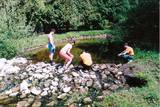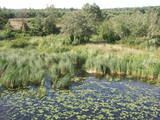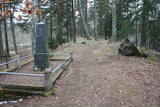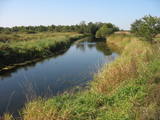| Нo | Название | Описание |
|---|---|---|
|
The trail informs visitors about one of the loveliest natural habitats in
|
||
|
Мастерская художницы находится в очень красивом хуторе. Ткёт гобелены и предлагает понаблюдать за ходом работы, заказать, а также приобрести готовые изделия. Многие из них - практические сувениры и используются как хорошие подарки. |
||
|
Деревня расположена в устье реки Ирбе (Dižirve, Īra), на обоих ее берегах (на «морской» стороне и на стороне «суши»). Ирбе впервые упоминается в 1310 году в пограничном договоре между Курземским епископом и Рижским домкапитулом, а название Лиелирбе (Irvemünde) впервые было внесено в арбитражный документ в 1387 году. В конце 19-го века малый порт Лиелирбе был активным центром торговли и транспорта древесины. В конце 19-го и начале 20-го века здесь было построено самое большое количество парусников среди всех поселений западного берега Курземе. В 1939 году в селе проживало около 300 жителей, насчитывалось более 70 домов и баптистская церковь (сейчас находится в Вентспилсском музее под открытым небом). Через поселок проходил узкоколейный паровоз, работало почтовое отделение и телеграф, имелись два продуктовых магазина, начальная школа 1-го класса, хор и духовой оркестр. Лиелирбе был одним из крупнейших поселений, исчезнувших после Второй мировой войны. В Лиелирбе родилась историк культуры Валда Мария Шувцане (1923 - 2007), работу которой продолжила ее дочь Байба Шувцане, создавая важные произведения о жизни ливского берега. До 2019 года планируется восстановить тросовый мост через реку Ирбе. |
||
|
Один из красивейших замков Латвии (стиль эклектизма), который хозяин замка Адольф фон Вульф подарил своей жене. По проекту архитектора Х. Гризенбаха он возводился в период с 1893 по 1896 гг. Рядом с замком на берегах речушки Сула раскинулся Цесвайнский парк, в котором находится поросшее лесом Цесвайнское городище. Завершены работы по реконструкции крыши Цесвайского замка! Замок открыт для посетителей с гидом из туристического центра. Звоните по телефону +371 26172637. Весной 2020 года строительные работы в замке будут продолжены, и замок может быть временно недоступен для посетителей. Информация об изменениях- www.cesvaine.lv |
||
|
Здесь ждут в гости как группы, так и индивидуальных посетителей. Хозяева предлагают насладиться баней по-черному, пообедать и попробовать испеченного по древним рецептам суйтского хлеба, пирогов и особого печенья с семечками. |
||
|
The Narūta River which flows out of Lake Ežezers is approximately 1 km long and ends at the small Obiteļi windmill lake. On the right bank of the river is a windmill that was built around 1900. Today the site has the Obiteļa leisure centre with a sauna and banquet facilities. |
||
|
The viewing tower is in a seaside meadow near Mērsrags. It is an unusual type of biotope in Latvia and is located to the North of the Mērsrags port. The tower offers a good view of reed-filled meadows, areas where wild cattle have grazed, and an amazing wealth of different kinds of plants. |
||
|
Close to Otepää, in a very beautiful place, surrounded by woods and hills, Canterville loss is waiting for you. A great place to relax with your family. Large playground for children. The restaurant serves both romantic meals and lunch during workshops. |
||
|
Vastseliina Castle dates from between the 14th and 17th centuries; during this time it was a mighty stronghold on the border between Russia and Europe and in the Middle Ages it was also a pilgrimage destination, it was destroyed in 1702 during the Great Northern War. |
||
|
The most populated place in The Curonian Spit - old curonian village - Nida. Until 19th century Nida's citizens were mainly fishermen. Later it became a popular resort. Like other villages here Nida has been "moved" because of "wandering dunes". There are a lot of museums to see. During tourism season there is around ~ 200 000 – 300 000 tourists here.
|
||
|
The restaurant and deli is located in Cēsis, on the way from Valmiera. Modern interior, relaxed atmosphere and delicious dishes from the produce of local farmers. The menu is rich not only with meat and fish dishes, but also with a wide range of vegetarian dishes. |
||
|
This is one of the most outstanding areas in the entire Baltic States with active underground waterways which still, to this very day, dissolve local gypsum rock. Parts of the area collapse regularly, and there are legends about all of this. Underwater rivers, streams, the so-called Karvės (Cow) cave, etc., can be seen in the area.
|
||
|
The “Gulbji” Selonian homestead is one of the very few places in Latvia where you can see a farm typical of the historical region of Selonia with its typical buildings. “Gulbji” is comparatively far from major roads and populated areas. It is on the so-called Dronku Island, not far from the beginning of the ancient Dviete River valley. The owners of “Gulbji” have collected a wealth of ancient household objects. Visitors can study the farm, examine a collection of medicinal plants, enjoy Selonian foods, or take a “black sauna.” It could be said that people at “Gulbji” have a natural farm which nurtures and maintains the traditions of the historical region. Latvian cuisine: Crepes, grit soup, cream of potato soup, beans sautéed in a special sauce, fruit dessert, bread soup with whipped cream, tortes, herbal teas. Special foods: Zeppelins. |
||
|
The ship "Baltā Kaza" transports tourists along the Daugava and also acts as a ferry from Jaunjelgava to Skriveri. In the summer season it runs at regular times. Excursions and trips to the Love Island, Aizkraukle castle ruins, Ķegums HPP, etc. are also possible. Other routes are possible. 25 passenger seats. During the trips you can get acquainted with the narration of cultural-historical, historical and biological objects on both banks of the Daugava. The owner organizes events and concerts both on the Daugava and on the bank of the Daugava. Possibility to rent SUP boards, rowing and canoe boats, catamarans at the berth. |
||
|
The first written records of the manor date from 1422, its fate in the 20th C was very chequered with changing hands and functions many times. Today there is a ceramic workshop where you can buy a range of products, model your own pieces, or decorate or glaze blank items to your taste. A woodwork shop shows various woodworking techniques. |
||
|
Viengadīgo krāšņumaugu, ēdamaugu dēstu audzēšana. Dažādu krāsu un formu tomātu audzēšana segtajās platībās. Ar 2021. gadu tomātu pārstrāde - sulas un pulvera ražošana. |
||
|
This is a territory which regularly floods when the Lielupe River crosses its banks. These are flood-land meadows of importance to birds. The area can be surveyed from the Rīga-Liepāja highway and the Kalnciems road which runs along it. |
||
|
The Middle Ages and the beginning of the last century cemetery at the church of Mazirbe. It is surrounded by a moss-covered stone fence. There you can find a number of interesting sights-Werewolf's Tomb, Old Taizelis Tomb, Grand Pine, etc.. |
||
|
As you travel from Kandava to Sabile, you will find a parking lot on the right side of the road. From there, there are steps to a viewing area on the highest hill in the Abava Ancient River Valley – Greiļi Hill. This offers a wonderful view of the ancient river valley and the local mosaic of meadows and forests. The landscape is enriched by the Imula and Amula valleys that are on the other side of the ancient river valley.
|
||
|
Palieņu un mitrās pļavas abos Dubnas upes krastos, kuras nelielā posmā var vērot no Rožupes - Vārkavas ceļa. Piemērotā laikā šeit dzirdēsiet griezes balsi, kas ir Eiropā izzūdoša putnu suga.
|
||



























